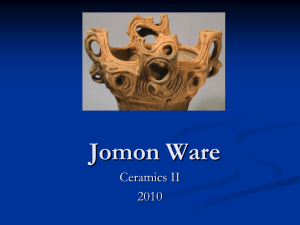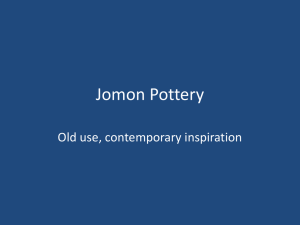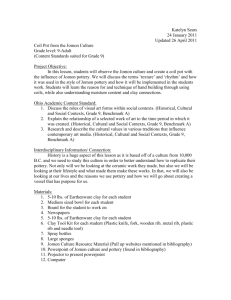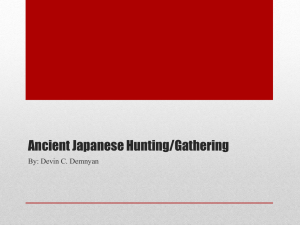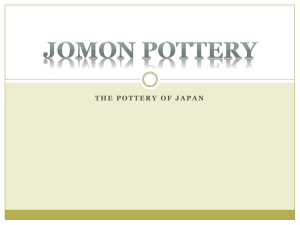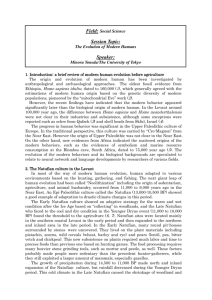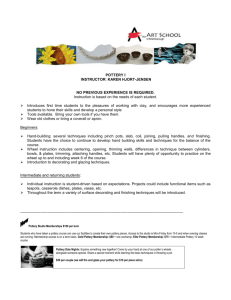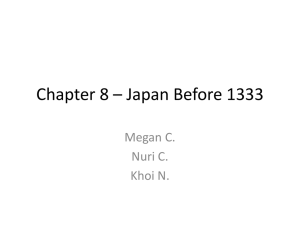Jomon pottery
advertisement
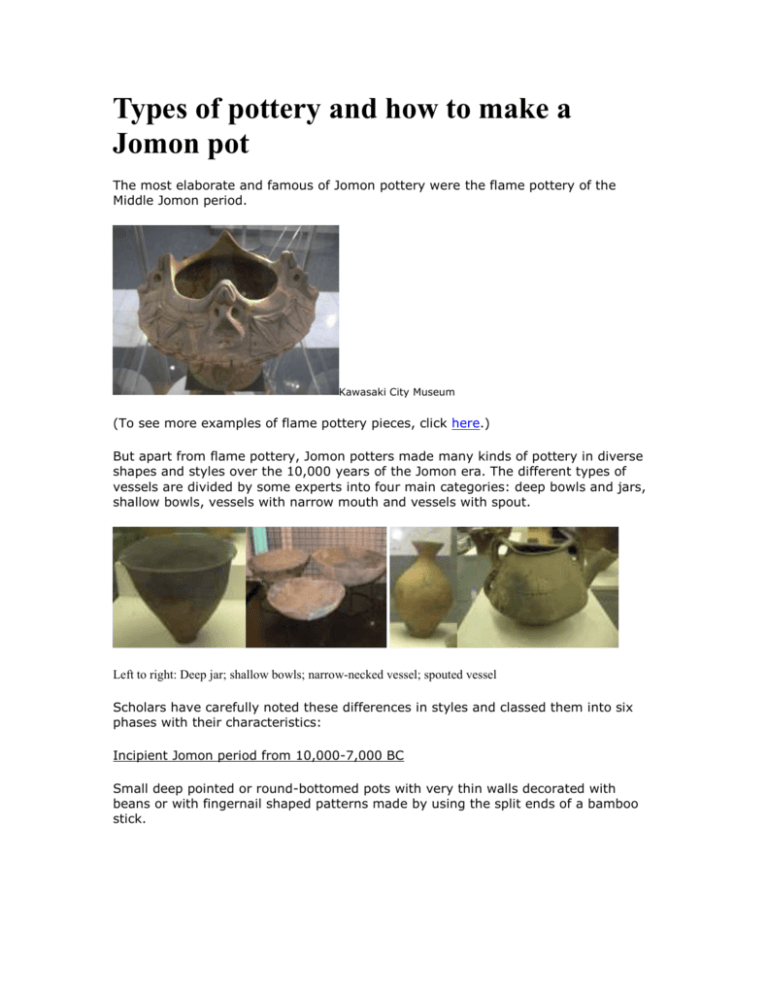
Types of pottery and how to make a Jomon pot The most elaborate and famous of Jomon pottery were the flame pottery of the Middle Jomon period. Kawasaki City Museum (To see more examples of flame pottery pieces, click here.) But apart from flame pottery, Jomon potters made many kinds of pottery in diverse shapes and styles over the 10,000 years of the Jomon era. The different types of vessels are divided by some experts into four main categories: deep bowls and jars, shallow bowls, vessels with narrow mouth and vessels with spout. Left to right: Deep jar; shallow bowls; narrow-necked vessel; spouted vessel Scholars have carefully noted these differences in styles and classed them into six phases with their characteristics: Incipient Jomon period from 10,000-7,000 BC Small deep pointed or round-bottomed pots with very thin walls decorated with beans or with fingernail shaped patterns made by using the split ends of a bamboo stick. Incipient Jomon Pot (10,000-8,000 BC), Tokyo National Museum (Pay a virtual visit the Niigata Prefectural Museum of History’s collection also to see its collection of Incipient Jomon pottery.) Initial Jomon period from 7,000-4,000 BC Round-bottomed or tapered pots decorated with cord-markings made by rolling rope over the sides of the pot, or with linear patterns and seashell impressions. Tokyo Maibun Archaeological Center Early Jomon period from 4,000-3,000 BC Pots with incised decorations and carved or sculpted rims, and that were sometimes lacquered. Tokyo Maibun Archaeological Center The shallow bowl appears in the Early Jomon and is usually used during ceremonies or to be buried with the dead as grave goods. Tokyo National Museum Middle Jomon period from 3,000-1,000 BC Pots and other vessels with thick walls, intricate or flamboyant decorations and patterns, particularly patterns that look like leaping flames. Tokyo National Museum The vessels were sometimes moulded with human faces, snakes and other animal motifs. Left: Tokyo Maibun Archaeological Center; Right: Tokyo National Museum Lamp-shaped pottery first appear during this period. Tokyo Maibun Archaeological Center Late Jomon period from 2,000-1,000 BC Pots were made with finer clay, had thinner walls and came in a wider variety of shapes and styles, including some with spouts. Late Jomon vessels were less decorative and simpler than earlier-made ones. Smooth burnished dark look and curved patterns were preferred. Cord-marked patterns also came back into fashion. Kawasaki City Museum Final Jomon period from 1,000-400 BC Pots and their rims were even simpler in design, and a cloud-like pattern of long Sshaped lines became common. Tokyo National Museum More types and styles of pottery were made including shallow bowls and vessels on stands. Tokyo National Museum How a Jomon pot was made Jomon potters did not use a potter’s wheel but made their pottery by kneading and coiling ropes of clay, then smoothing them together by hand to get a continuous surface. The pottery were sometimes tempered or strengthened with crushed shells, fibres, lead, mica or fool’s gold(phlogopite found only in mountains north of Tokyo and in old streambeds of Kanto regions). Fool’s gold resulted in more heat-resistant clay that baked well and contracted less while drying. The pottery was then low-fired at temperatures below 900 degrees Celcius. To learn how to make a coiled pot, take this online tutorial. Decorations were then added by incising (scratching) with sticks or shells or by rolling cords or ropes over the surface of the pots. What were the different Jomon pottery used for? The most common pots were deep bowls or jars that turned up everywhere and throughout the Jomon era. Some had wide necks. Since most of the deep pots excavated had sooty or scorched bottoms, we know they were used for cooking or storage and others, but more rarely, for rituals including burials of the dead. Shallow bowls appeared from Early Jomon times, but were used mostly as grave goods. More shallow bowls were made in the later periods and were used for a special ceremonies. Tokyo Maibun Archaeological Center For various ceremonies, lamp-shaped pottery and incense-burner shaped ones were also invented. Tokyo National Museum A few of the early pots had a unique shape with a square mouth and flat bottom though the majority were round. Kawasaki City Museum Many of the early deep pots had pointed bottomed pots useful for sitting well in the sand or soil of bonfires, but flat bottomed ones were more common after the Early Jomon period. Tokyo National Museum In the later periods, pots of more shapes and sizes appeared including ceremonial vessels with spouts and vessels with narrow mouths, often with long necks. Tokoro Archaeological Center, Hokkaido Some scholars think spouted vessels may have been used to contain and pour wine offerings. In the last part of the Jomon era, pottery designs and patterns became finer and plainer and they learnt to make burnished dark pottery as well. Kawasaki City Museum From Early Jomon days, some Jomon people learnt how to make lacquer using sap from the Rhus verniciflora tree which was sometimes used to coat the insides or outsides of some of the pottery either for decoration or to make the pots waterproof. Lacquering was a very difficult and time consuming process, such pottery was most likely used for ceremonial purposes only. The red coloring of lacquered ware comes from the use of bengara or oxidised iron. In other discoveries at a site in Kagoshima prefecture, bengara or oxidised iron was used to color Jomon earthenware red. Red is a magical color to the Jomon people. Tokyo National Museum Flame type pottery found in Niigata Prefecture. This pottery is also called kaen doki. Middle Jomon pot from Niigata Prefecture. Middle Jomon bowl found in Niigata Prefecture. Middle Jomon pot from Niigata Prefecture.
